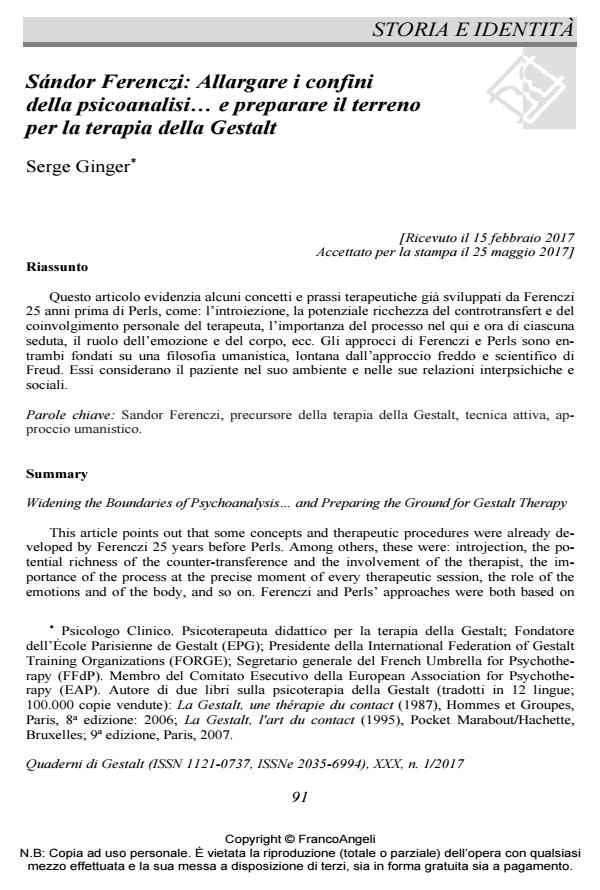Widening the Boundaries of Psychoanalysis... and Preparing the Ground for Gestalt Therapy
Journal title QUADERNI DI GESTALT
Author/s Serge Ginger
Publishing Year 2017 Issue 2017/1 Language Italian
Pages 10 P. 91-100 File size 198 KB
DOI 10.3280/GEST2017-001007
DOI is like a bar code for intellectual property: to have more infomation
click here
Below, you can see the article first page
If you want to buy this article in PDF format, you can do it, following the instructions to buy download credits

FrancoAngeli is member of Publishers International Linking Association, Inc (PILA), a not-for-profit association which run the CrossRef service enabling links to and from online scholarly content.
This article points out that some concepts and therapeutic procedures were already developed by Ferenczi 25 years before Perls. Among others, these were: introjection, the potential richness of the counter-transference and the involvement of the therapist, the importance of the process at the precise moment of every therapeutic session, the role of the emotions and of the body, and so on. Ferenczi and Perls’ approaches were both based on humanistic philosophy and very far from the cold and scientific approach of Freud. Their approaches considered the patient in his own environment and in his interpersonal and social relationships.
Keywords: Sandor Ferenczi, precursor of Gestalt therapy, active technique, humanistic approach.
- Barande I. (1972). Sándor Ferenczi. Paris: Petite Bibliothèque Payot.
- Borch-Jacobsen M. (2002). Folies à plusieurs. Paris: Les empêcheurs de penser en rond.
- Bourdin D. (2000). La psychanalyse, de Freud à aujourd'hui. Rosny: Bréal.
- Fages J.B. (1991). Histoire de la psychanalyse après Freud. Toulouse: Privat.
- Ferenczi S. (1974). Psychanalyse III (1919-1926). Paris: Payot.
- Ferenczi S. (1982). Psychanalyse IV (1927-1933). Paris: Payot.
- Ferenczi S. (1985). Journal clinique (jan.-oct. 1932). Paris: Payot (trad. it.: Diario clinico (Gennaio-Ottobre 1932). Milano: Raffaello Cortina, 2004).
- Ferenczi S., Rank O. (1923). Perspectives de la psychanalyse. Paris: Payot (trad. it.: Prospettive di sviluppo sulla Psicoanalisi. Sull’interdipendenza tra teoria e pratica. Psicoterapia e Scienze Umane, 2012, XLVI, 4: 487-538).
- Ferenczi S., Groddeck G. (1982). Correspondance (1921-1933). Paris: Payot.
- Gay P. (1988). Freud. A Life for Our Time. New York: Norton (trad. fr.: Freud, une vie. Pa-ris: Hachette, 1991).
- Ginger S. (1995). La Gestalt: l’art du contact. Paris: Hachette/Marabout, 2003.
- Ginger S., Ginger A. (1987). La Gestalt, une thérapie du contact. Paris: H&G, 2003 (trad. it.: La Gestalt: terapia del “con-tatto” emotivo. Roma: Edizioni Mediterranee, 2004).
- Granov W. (2001). The Future of the Œdipical Complex. St. Petersburg: East European Psychoanalytic Institute.
- Haynal A. (1996). La psychanalyse: 100 ans déjà. Genève: Georg.
- Roudinesco E., Plon M. (1997). Dictionnaire de la Psychanalyse. Paris: Fayard.
- Sabourin P. (1985). Ferenczi, Paladin et Grand Vizir secret. Paris: Editions Universitaires.
- Per maggiori dettagli, vedi la Bibliografia di 14 pagine, composta di libri e articoli, nella Revue française de psychanalyse, numero speciale su Ferenczi, PUF, 1995.
Serge Ginger, Sándor Ferenczi: Allargare i confini della psicoanalisi... e preparare il terreno per la terapia della Gestalt in "QUADERNI DI GESTALT" 1/2017, pp 91-100, DOI: 10.3280/GEST2017-001007